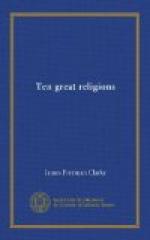It is more than forty years since the writer, then a boy, was one day searching among the heavy works of a learned library in the country to find some entertaining reading for a summer afternoon. It was a library rich in theology, in Greek and Latin classics, in French and Spanish literature, but contained little to amuse a child. Led by some happy fortune, in turning over a pile of the “Monthly Anthology” his eye was attracted by the title of a play, “Sacontala,[30] or the Fatal Ring; an Indian Drama, translated from the original Sanskrit and Pracrit. Calcutta, 1789,” and reprinted in the Anthology in successive numbers. Gathering them together, the boy took them into a great chestnut-tree, amid the limbs of which he had constructed a study, and there, in the warm, fragrant shade, read hour after hour this bewitching story. The tale was suited to the day and the scene,—filled with images of tender girls and religious sages, who lived amid a tropical abundance of flowers and fruits; so blending the beauty of nature with the charm of love. Nature becomes in it alive, and is interpenetrated with human sentiments. Sakuntala loves the flowers as sisters; the Kesara-tree beckons to her with its waving blossoms, and clings to her in affection as she bends over it. The jasmine, the wife of the mango-tree, embraces her lord, who leans down to protect his blooming bride, “the moonlight of the grove.” The holy hermits defend the timid fawn from the hunters, and the birds, grown tame in their peaceful solitudes, look tranquilly on the intruder. The demons occasionally disturb the sacrificial rites, but, like well-educated demons, retire at once, as soon as the protecting Raja enters the sacred grove. All breathes of love, gentle and generous sentiment, and quiet joys in the bosom of a luxuriant and beautiful summer land. Thus, in this poem, written a hundred years before Christ, we find that romantic view of nature, unknown to the Greeks and Romans, and first appearing in our own time in such writers as Rousseau, Goethe, and Byron.
He who translated this poem into a European language, and communicated it to modern readers, was Sir William Jones, one of the few first-class scholars whom the world has produced. In him was joined a marvellous gift of language with a love for truth and beauty, which detected by an infallible instinct what was worth knowing, in the mighty maze of Oriental literature. He had also the rare good fortune of being the first to discover this domain of literature in Asia, unknown to the West till he came to reveal it. The vast realm of Hindoo, Chinese, and Persian genius was as much a new continent to Europe, when discovered by Sir William Jones, as America was when made known by Columbus. Its riches had been accumulating during thousands of years, waiting till the fortunate man should arrive, destined to reveal to our age the barbaric pearl and gold of the gorgeous East,—the true wealth of Ormus and of Ind.




